
Polaris, also known as the North Star, is widely recognized as one of the most prominent stars in the night sky. What do astronomers currently understand about this celestial object? We have compiled a list of ten intriguing facts about Polaris, encompassing both well-known information for amateur astronomers and potentially groundbreaking discoveries.
-
However, unlike the ever-changing nature of the cosmos, Polaris remains steadfast and unwavering in its position. It stands alone, unparalleled in the vast expanse of the sky. While countless stars glimmer and flicker above, Polaris remains fixed, a beacon of constancy.
Fact No. 1. Polaris is not the most luminous celestial object in the firmament.
The misconception that Polaris is a highly luminous star is one of the most widespread misconceptions in astronomy. Many individuals who are not well-versed in the celestial sphere falsely believe that Polaris is exceptionally bright, if not the brightest, star in it. However, this is not the case! Polaris ranks 46th in the list of the brightest stars in the sky, far behind stars like Sirius, Vega, and Arcturus. Polaris’ luminosity is roughly equivalent to a 2nd magnitude star, which is similar to the stars in the handle of the Big Dipper. Consequently, in a large urban area where the night sky is not truly dark but rather illuminated by streetlights, Polaris is often challenging to locate! So, where does the misconception that Polaris is the brightest star originate from? Presumably, this misconception stems from its popularity and the significant role that Polaris plays in society. However, let us reiterate that Polaris has attained its fame not due to its luminosity, but rather due to its unique position in the sky.
Undoubtedly, many individuals have observed that the image of the starry firmament alters based on the time of day. The constellations that were visible in the evening, let’s say, in the southern region, shift towards the western part during the night, and by morning, they descend below the horizon. On the other hand, different constellations that ascended in the east during the evening are already positioned high in the southern segment of the sky during the night. The stars, as they appear to us, appear to be affixed to the celestial sphere and revolve alongside it, moving from east to west with a day-long cycle. However, it should be recognized that the notion of a celestial sphere is purely hypothetical– and the east to west movement of the stars merely reflects the actual rotation of the Earth from west to east!
The movement of the stars can be easily observed in photographs captured with stationary cameras and long exposure times. In this particular photo, the exposure lasted for 5 hours, allowing for a clear depiction of the stars’ paths. The arcs created by the stars cover approximately one-fourth of the circle’s circumference. Notably, Polaris, the North Star, exhibits the shortest arc among all the stars that can be seen without the aid of telescopes or binoculars. Image credit: Anthony Ayiomamitis
The Earth spins like a wolf – around a lone axis; the points where the Earth’s axis of rotation intersects with the planet’s surface are known as the Earth’s North and South Poles. By extending the Earth’s axis of rotation into the sky. the celestial sphere has its own north and south poles. or, as astronomers refer to them, the poles of the universe. Now let’s envision ourselves at the North Pole. There is ice, tranquility, and a clear sky… Throughout the day, all the stars trace circles in the sky, but as they approach the point directly above. their circles become smaller. This is understandable, since the point directly above is the north pole of the universe, around which all the stars revolve! Consequently, near the point directly above, the stars appear almost motionless, tracing very tiny circles around it. Polaris is exceptional in that it is closer than any other visible star to the north pole of the universe. at a distance of about 1°. Due to this, it remains virtually in the same position, regardless of the time of day or year. The steadfastness of Polaris for thousands of years makes it a true guide for sailors, shepherds, and explorers.
It is a known fact that the North Pole of the Earth is only about 1° away from Polaris, the North Star. However, the daily path that Polaris traces around the North Pole is barely perceptible to the naked eye. Image: Rogelio Bernal Andreo/Big Universe
It is evident that only in the Earth’s sky does Polaris hold a special position. In the skies of other planets, different stars play the role of Polaris due to the varying tilts of their rotation axes in relation to the planes of their orbits. Interestingly, in our own sky, the situation has not always been the same. Thousands of years ago, Vega served as the polar star when the Earth’s rotation axis pointed in a different direction. The Earth’s rotation axis is constantly in motion, describing a circle in the sky over a period of 25800 years. This phenomenon is known as precession, derived from the Latin term precession of the equinoxes. The cause of precession is the slight flattening of the Earth, which results in the Moon and other celestial bodies gradually exerting a force on the Earth’s axis and causing it to shift.
Circle of precession. The Earth’s axis completes one full revolution every 26,000 years. Approximately 2,000 years ago, the star Kohab (or beta of the Little Bear) was the closest to the North Pole. In another 2,000 years, the pole of the world will come closer to the star Errai (gamma Cepheus). And in another 12,000 years, it will be close to the bright star Vega. Illustration: The Vast Universe
Where is the world’s axis currently moving towards? Currently, it is still pointing towards Polaris. It’s important to note that Polaris is not exactly at the celestial pole, but rather about 1° away from it. By 2100, this distance will be reduced by half, and then the world’s pole will gradually start moving away from the star, continuing its motion towards the constellation Cepheus.
How can one navigate using Polaris? The first step is to locate it in the sky. The simplest way to do this is to start from the handle of the Big Dipper – the most well-known star formation. Take the two outermost stars in the Dipper (known as Dubge and Merak) and mentally draw a straight line connecting them. Polaris is located at a distance five times greater than the distance between Merak and Dubge. The color of Polaris is yellowish-white and it shines with a brilliance similar to these stars.
Polaris can be easily found by extending the line connecting Merak and Dubge upwards from the edge of the Big Dipper. Polaris is located at a distance five times greater than the distance between these two stars and shines with the same brilliance. Figure: The Vast Universe
After identifying Polaris, we can create a line from it that is perpendicular to the horizon. The point where this line intersects the horizon will indicate the north direction, and it can do so with greater accuracy compared to a compass! It is also easy to determine the other directions: south is in the opposite direction, east is to the right, and west is to the left of Polaris. Another fascinating and significant characteristic of Polaris is its altitude above the horizon. We have already mentioned that Polaris is virtually stationary for this specific location due to its proximity to the Earth’s pole. However, the star’s altitude above the horizon can vary depending on your geographic location! For instance, if we were at the North Pole, we would see Polaris directly above us, at the zenith. On the other hand, if we were at the equator (which is like being on the side of the Earth), Polaris would be almost exactly on the horizon. Hence, the altitude of Polaris above the horizon determines our latitude. In the past, mariners used to measure the angle between Polaris and the horizon towards the north each night to determine how far north or south they had traveled.
Interesting Fact #4: Polaris, the Brightest Star in the Little Bear Constellation
Polaris, also known as the North Star, holds the title of being the brightest star in the constellation of the Little Bear. This small constellation may not be as visually striking as others, but it has its own charm. One of its notable features is the Little Bucket asterism, which is made up of seven stars. However, unlike its counterpart, the Big Bucket, the Little Bucket only contains three stars that are relatively bright. As a result, spotting the Little Bear constellation in the night sky can be quite challenging.
During autumn evenings, the Big Dipper can be observed low on the horizon in the northern part of the sky. By following its direction upwards, one can easily locate the Little Dipper. The handle of the Little Dipper curves in a different direction compared to the handle of the Big Dipper. Polaris, the outermost star in the handle of the Little Dipper, serves as a reliable marker for finding the North Star. With the help of astronomical software like Stellarium, stargazers can explore and appreciate the beauty of this celestial wonder.
The Little Dipper consists of three main stars, each with its own unique name. Polaris is the outermost star located in the handle of the Little Dipper. Cohab and Ferkad, on the other hand, are the outermost stars within the Bucket itself. They are often referred to as the Guardians of the Pole. Astronomers have a tradition of assigning Greek letters to the brightest stars in constellations. The brightest star is typically labeled as “alpha,” the second brightest as “beta,” and so on, with “omega” being the last letter (although there are occasional exceptions to this rule). Therefore, Polaris is also known as the alpha (α) star of the Little Bear. Kohab, which is slightly less bright, is labeled as beta (β), and Fercad is designated as gamma (γ) of the Little Bear.
Fact #5. Polaris is known by multiple names
There are few stars that have as many names as Polaris. The majority of these names focus on its two main characteristics: its position at the pole and, consequently, its lack of movement. Many cultures saw Polaris as a sort of stake driven into the sky, around which all other stars revolved. This is why it is known by names such as Heavenly Stake, Prikol-star, Iron Stake, and Northern Nail in Turkic and Finno-Ugric languages. In Russia, the name Polar came from German during the time of Peter the Great. Before that, the Polar Star had a different name with the same meaning – Severnaya. The Khakasses had a more poetic name for Polaris – the Bound Horse, which refers to the star’s immobility. The Evenks saw Polaris as A hole in the sky. There are very few names for Polaris that do not relate to its position. One of the most well-known of these names is Kinosura, which comes from the Greek word Κυνόσουρα meaning “tail of the dog”. This was the name given to Polaris by the ancient Greeks and Romans, although at that time Polaris did not yet serve as the pole star (2000 years ago, the star Kohab or β of the Little Bear was closer to the North Pole). Interestingly, ancient maps depict Polaris as a tail, but not a dog’s tail – rather, it is an elongated tail that does not exist in nature and is associated with the Big Dipper.
There exists an intriguing hypothesis regarding the origin of the name Kinosura. According to Allen and other researchers of celestial bodies, the complete constellation of Ursa Minor was known by this name in ancient times. In one version of the myth surrounding the birth of Zeus, the young god was nourished in a cave by two bears, namely Helica (or Helis) and Kinosura, who were subsequently elevated to the heavens by a grateful Zeus. Helica transformed into the Big Dipper, while Kinosura became the Minor Dipper. Eventually, this name came to be associated solely with Polaris. In light of this tale, one can’t help but wonder: from where did the bear acquire such an unusual name!
Fact #6. Polaris: A Supergiant Star
Let’s now examine the physical attributes of Polaris. Even when observed through binoculars, its yellowish hue is easily distinguishable. Polaris is only slightly hotter than the Sun, with a surface temperature of approximately 6000 K. However, the similarities to the Sun end there. Polaris, like the majority of stars visible to the naked eye, shines much brighter than our Sun. Brighter than the Sun. Spectral analyses indicate that this star belongs to the class of supergiant stars. Of supergiant stars. With a radius 46 times greater than that of the Sun and a luminosity approximately 2500 times that of the Sun, Polaris is truly remarkable. We use the term “approximately” because the exact magnitude of Polaris’ luminosity remains unknown, mainly due to astronomers’ limited knowledge of its distance. However, we will discuss this further below.
The Large Universe presents the position of Polaris on the Hertzsprung-Russell diagram. The X-axis represents the spectra, indicating the temperature of the stars. The Y-axis represents the luminosity, measured in luminosities of the Sun.
Stars like Polaris, which possess these qualities, make up only a small fraction of the total number of stars in the Universe. However, they are the most prominent ones visible in the sky due to their higher brightness compared to other stars. So, what makes supergiant stars so rare? The reason is that the supergiant phase in a star’s life is extremely short-lived and occurs only after the nuclear fuel in its core has been depleted. Stars such as Polaris are always old and highly evolved celestial objects. This does not necessarily mean that their actual age is large – in fact, Polaris is no older than 70 million years. However, their life cycle, unlike that of the Sun, is already approaching its end. By understanding the physical characteristics of Polaris in the present era, we can speculate about its nature during the majority of its existence. It is highly probable that Polaris was initially a bright blue star belonging to the spectral class B, with a mass five times that of the Sun and a radius 3.5 times greater than that of the Sun. Its surface temperature was three times higher, measuring around 18000 K.
Fact #7. Polaris stands out as the most brilliant and unique cepheid in the celestial sphere
Once the majority of hydrogen in the star’s core is converted into helium, the star goes through a phase of instability. The core’s radiation pressure weakens, causing it to shrink, while the outer layers of the star expand, turning it into a giant or even a supergiant. Additionally, the star starts to pulsate as it undergoes fluctuations in size, temperature, and brightness. Polaris also exhibits pulsations as it expands and contracts. As a result, its luminosity experiences slight changes, although they are not perceptible to the naked eye. The pulsations of Polaris are highly rhythmic and have a period of 3.97 days, functioning like a clock. Astronomers have discovered many similar stars, which have been classified as a distinct group called Cepheid stars (named after the prototype star δ Cepheus). Despite their similar pulsations, Cepheids are not identical. They vary in mass, size, temperature, and consequently, pulsation amplitude and period. However, all Cepheids share an intriguing common characteristic: their pulsation periods are directly related to their luminosity (the amount of light they emit). In other words, the longer the period, the greater the luminosity of these stars. This discovery played a crucial role in astronomy, enabling scientists to determine the distance to other galaxies. There are approximately 40 classical Cepheids visible to the naked eye, with Polaris being the brightest and closest among them. Consequently, astronomers have extensively studied its variability over the past century. They have found that Polaris is quite unpredictable. In the early 1970s, the amplitude of Polaris’ light varied by 0.27 m, a change that is almost detectable by the naked eye. Subsequently, the already small amplitude of Polaris’ pulsations decreased significantly. Some astronomers even speculated that by the beginning of the 21st century, the star would no longer exhibit Cepheid-like behavior. They proposed that Polaris might be the first recorded instance of a Cepheid star ceasing to pulsate due to its departure from the instability strip as a result of evolution. However, around 1993, the decrease in the amplitude of Polaris’ pulsations abruptly ceased, and since then, it has remained at 0.032 m. Simultaneously, the star’s brightness has increased by 15%.
It is interesting to note that the outer and inner atmospheres of Polaris oscillate in counter-phase, unlike classical Cepheids. This phenomenon is observed in the first overtone mode. Some astronomers speculate that this suggests that the star’s pulsations do not cease, but instead it is transitioning to the main period of 5.7 days, eventually becoming a regular Cepheid with significant fluctuations in brightness.
Fact #8. Polaris has dimmed over time
Therefore, the luminosity of Polaris has increased by 15% over the past century. This is an indisputable fact. But what if we delve even further into the past? How bright was Polaris 2000 years ago? Scott Engle, a graduate of Villanova University, decided to reanalyze the data on the brightness of Polaris recorded in the catalogs of Ptolemy (137 AD), As-Sufi (964 AD), Ulugbek, Tycho Brahe, and other astronomers. Standardizing the data, he discovered that the current Polaris is 2.5 times brighter than it was during Ptolemy’s era! A whole star magnitude difference! Is this even possible? If Engle and his team’s findings are accurate, then the luminosity of Polaris has changed over the past two millennia by a factor of 100 more than what the current theory of stellar evolution predicts. Unsurprisingly, most scientists were skeptical of the astronomers’ research. However, Engle and his team uncovered hints in ancient sources of variations in Polaris’ brightness with a 4-day period, suggesting that the amplitude of these variations may have been much greater in the past. This study was published in the reputable journal Science, which lends it some credibility. However, it does not mean that Engle’s conclusions are definitive.
Fact #9. Polaris consists of three stars
We are accustomed to referring to Polaris as a star, but in reality it is a system of stars. Not only is Polaris a triple star, but it also has two companion stars that are bound to it by mutual gravity. One of these companions, known as Polaris B, can be seen in small amateur telescopes. It is a small star, about 9 times smaller than Polaris, and is located about 18 angular seconds away from Polaris. It was first observed by the astronomer William Herschel in 1780. Polaris B is an ordinary star of spectral class F3V, about 4 times brighter than the Sun and 1.4 times more massive. If you have a telescope, I recommend taking a look at Polaris through it! Next to the yellowish-white Polaris, its faint companion appears greenish. However, the color of stars is never actually green – this is just an optical illusion caused by the proximity of the companion to Polaris. The second component of the system, known as Polaris Ab, is even closer to Polaris and was only observed for the first time in 2006 by the Hubble Space Telescope. The angular distance between Polaris A and Polaris Ab is only 0.133″, which is about the size of a ruble coin seen from a distance of 30 kilometers!
In actuality, the separation between Polaris A and its nearest companion is at minimum 2 billion kilometers. They require approximately 30 years to complete a single orbit around a shared center of mass. Polaris Ab shares similar characteristics with Polaris B. B. It is classified as a F6V star, 1.26 times more massive than the Sun, and three times brighter than our own stellar body.
Polaris comprises a trinary star system. Polaris A is the luminous supergiant star positioned at the lower portion of the illustration. Polaris B, located 18 arc seconds away, is already discernible through amateur telescopes, while Polaris Ab is in such proximity to Polaris A that it was only discovered in 2006 via the Hubble Space Telescope. Illustration: NASA, ESA, G. Bacon (STScI)
Fact #10. Distance to Polaris
Polaris, also known as the North Star, is a well-known star that has been used for navigation for centuries. It is located in the constellation Ursa Minor and is known for its close proximity to the North Celestial Pole. But do you know how far away Polaris actually is from Earth?
The distance to Polaris is approximately 434 light-years. This means that the light we see from Polaris today actually left the star 434 years ago. Considering that light travels at a speed of about 186,282 miles per second, it’s mind-boggling to think about how long it takes for the light to reach us.
Despite being relatively close in astronomical terms, Polaris is still incredibly far away. Its distance makes it impossible for us to visit or observe up close. Instead, we can only admire and study it from a distance.
Polaris is not only interesting because of its distance, but also because of its role in navigation. Due to its close proximity to the North Celestial Pole, it appears to stay in the same place in the night sky while other stars appear to move throughout the night. This makes it a useful point of reference for navigators, especially those in the Northern Hemisphere.
So the next time you gaze up at the night sky and spot Polaris, remember that you are looking at a star that is hundreds of light-years away. It’s a humbling reminder of just how vast and mysterious the universe truly is.
We have mentioned earlier that Cepheids hold a crucial role in the field of astronomy. These stars serve as unique beacons of the Universe, allowing astronomers to accurately calculate the distances to other galaxies. The process works as follows: Initially, astronomers measure the distance to nearby and bright Cepheids directly using the trigonometric parallax method. They also carefully observe the luminosities and pulsation periods of these stars, using their known luminosity and distance as references. By accumulating data on all Cepheids with known distances, astronomers can establish a formula that correlates the pulsation period of these stars with their luminosity. This formula enables them to determine the distance to even the most distant Cepheids, for which parallax measurements are not feasible. This method was instrumental in the groundbreaking work of American astronomer Edwin Hubble, who, in the late 1920s, used Cepheids in the Andromeda Nebula to determine its distance, thereby proving the existence of other galaxies. Hubble also constructed the first distance scale in the Universe. The Cepheid method continues to be widely used today, forming the basis of our understanding of the scale, size, and distances of other galaxies. However, there is a limitation. As mentioned earlier, Cepheids are relatively rare, making it unsurprising that there are no such stars in close proximity to the Sun. The nearest Cepheid, Polaris, is still quite distant, with an estimated distance of about 400 light-years. At this distance, parallax measurements introduce a significant margin of error. The most accurate parallax measurement of Polaris to date, conducted by the Hipparcos satellite, has an error of 8 light-years or approximately 2%. This raises doubts about the accuracy of the distances measured not only to Polaris but also to the other ~120,000 stars that were surveyed. Astronomer David Turner recently published a paper in which he argued that the modern distance to Polaris is actually 111 light-years less than the measurement obtained by Hipparcos. Turner’s research utilized the BTA telescope, the largest Russian telescope with a mirror diameter of 6 meters. Together with a team of Russian astronomers, they extensively analyzed Polaris’ spectrum and discovered that the star emits less light than previously believed based on parallax measurements. Does this mean that the Hipparcos satellite inaccurately measured the distance to Polaris? And what about the distance to the other stars? In response to Turner’s claims, Dutch astronomer Floor van Leeuwen, the current custodian of the Hipparcos data, published a rebuttal paper in which he defended the accuracy of the satellite’s measurements, contrasting them with Turner’s findings. This debate quickly spread across the Internet and attracted the attention of various media outlets, highlighting the significance of the issue not only in academia but also in the broader worldview. Accepting the new distance to Polaris would imply a significant overestimation of the true scale of the Universe. It could potentially call into question the prevailing understanding of the rate of expansion of the Universe, a topic that has already been honored with a Nobel Prize in 2011. So, who is correct? Astronomers are not rushing to dismiss the Hipparcos data, but they are also considering Turner’s arguments seriously. Barbara McArthur, a research astronomer from the University of Texas, plans to gather new data and determine the parallax of Polaris’ companion star, Polaris B, which is located at a similar distance from Earth as the primary star. The results of this research will become available in the next couple of years. Source: http://www.biguniverse.ru/posts/polyarnaya-zvezda-10-faktov/

Polaris, also known as the alpha of the Little Bear or Kinosura, is a supergiant star of spectral class F71b with a stellar magnitude of +2.0. It is positioned near the North Pole of the world and is located approximately 431 light-years away from Earth. The precise coordinates of Polaris are 02 h 31 m 48.7 s+89°15'51'. During our current epoch, Polaris is situated less than 1° away from the North Pole, making it nearly stationary as the starry sky rotates. This characteristic makes it useful for orienteering and determining the direction of north. The Earth’s axis undergoes precession, causing slight shifts in the position of the North Pole. By the year 2100, Polaris is expected to approach the North Pole at a distance of approximately 30'.
Polaris is the most luminous and nearest pulsating variable star of the delta Cepheus category, with a period of 3.97. Furthermore, it is an atypical Cepheid star. The oscillations of the star exhibit a unique characteristic of dimming over a span of several decades. Therefore, in the year 1900, there was an 8% increase in brightness, whereas in 2005, it was approximately 2%. Moreover, the star itself has experienced a 15% increase in luminosity.
Polaris is actually a triple star system. Its central star, Polaris A, shines 2000 times brighter than our Sun. Polaris B is located at a decent distance from Polaris A and can be observed from Earth with telescopes. However, Polaris AB is extremely close and can only be seen with the help of the Hubble telescope. The rotation period of Polaris AB is approximately 30 years. Despite the fact that in different time periods, the pole star was represented by different stars that appeared stationary in the sky, Polaris is the current proper name and is considered the alpha star of the Little Bear constellation. This is due to the luni-solar precession, which causes the Earth’s axis to move in a circular motion with a radius of 23°97 at a rate of about 0.5° per 100 years. As a result:
5,000 years ago, the pole star was known as Alpha Dragon.
During the beginning of the Common Era, there were no bright stars near the North Pole at all.
After 2000 years, gamma Cepheus will become the new Polaris.
In 12,000 years, alpha Lyra will be known as Vega.
Here is a list of the polar stars that make up the complete precession circle[1].
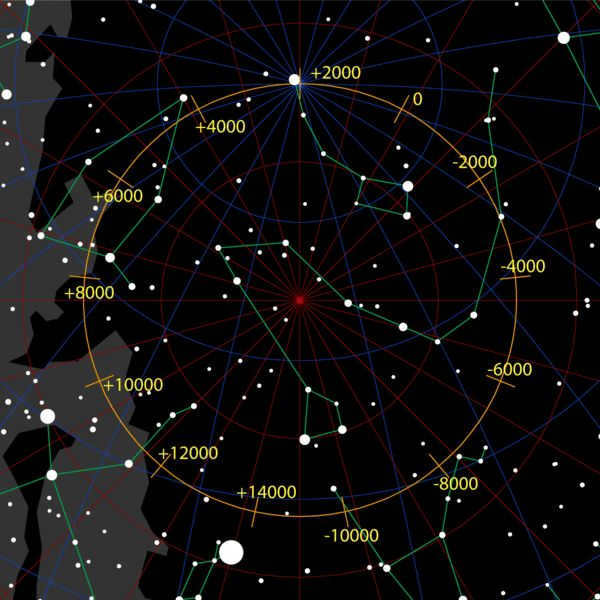
The transformation of polar stars during axis precession
In the year 13,000 B.C., the polar star was Vega (α Lyra).
In the 9th millennium B.C., the polar stars were alternately ? and ? (Hercules).
In the 8th-7th millennium B.C., the polar star was ? (τ Hercules).
From 5500 to 3500 B.C., the polar star was ? (ι Dragon).
From 3500 to 1500 B.C., the polar star was Tuban (α Dragon).
From 1500 B.C.E. to 1 A.D., the polar star was Kohab (β Little Bear).
From 1 to 1100 A.D., there was no polar star. However, there were “guardians” – Kohab (β Little Bear) and Kinosura (α Little Bear), and the pole was approximately equidistant from α and β of the Little Bear.
1100-3200. Polaris serves as the alpha star of the Little Bear constellation. It will reach its closest distance to the North Pole (27′) in the year 2100.
3200-5000. – The polar star will be Alrai, the gamma star of the Cepheus constellation.
5000-6500 yr. – The polar star will be Alfirk, the beta star of the Cepheus constellation.
6500-8500. – The polar star will be Alderamin, the alpha star of the Cepheus constellation.
8500-13,000 yr. – The polar star will be Deneb, the alpha star, and Sadr, the gamma star of the Swan constellation.
13,000 – Vega, the alpha star of the Lyra constellation, will become the polar star once again.
Navigation with Polaris as a reference point.
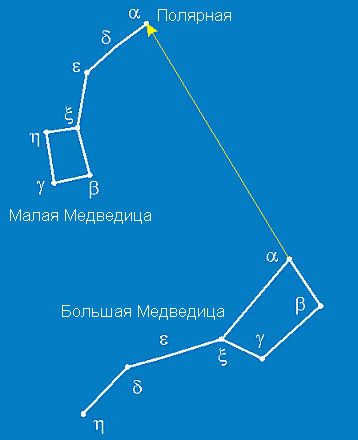
How to locate Polaris
Polaris is utilized for navigation purposes. It is always positioned above the northernmost point on the horizon in the northern hemisphere. To locate it, you first need to locate the constellation known as the Big Dipper, and through its ladle (specifically, the two stars Dubhe and Merak), opposite the “handle”, mentally measure five distances between these two stars. Polaris can be found approximately at the end of this line. The direction towards Polaris aligns with the direction towards the north, and its elevation above the horizon corresponds to the observer’s latitude.
This passage serves as an introductory excerpt.
Related Articles
What is the significance of Polaris, the second most well-known star after the Sun?
What exactly is Polaris, the second most famous star after the Sun? Polaris is the brightest star in the Little Bear constellation and can be found at the tip of its “tail”. It is situated approximately 450 light years from Earth and has an apparent sidereal magnitude of 1.5.
What is the length of the polar night at the North Pole? The polar night is the time period when the Sun remains below the horizon in the polar regions and there is no direct sunlight. The duration of the polar night increases as you go further north of the Arctic Circle.
Polaris
Polaris, also known as the North Star or Alpha Ursae Minoris, is a supergiant star with a magnitude of +2.0. It is located near the North Pole and can be found at coordinates 02 h 31 m 48.7s_+89° 15? 51?. Polaris belongs to the spectral class F71b and is approximately 431 light-years away from Earth.
“I am a superstar.”
“I am a superstar.” This interactive activity is designed to empower young individuals in our community, while promoting open and free expression among children. The game can accommodate any number of participants, and the larger the group, the more exciting it becomes. From the pool of participants, one child is selected to sit directly across from everyone else. This particular child
What is the most well-known star (besides the Sun) – Polaris?
Polaris, the brightest star in the constellation of the Little Bear, is situated at the end of its tail. It is positioned approximately 450 light years away from us and possesses an apparent stellar magnitude of 1.5 years.
What is the duration of the polar night at the North Pole?
What is the duration of the polar night at the North Pole? The polar night refers to the time when the Sun does not rise above the horizon in the polar regions, resulting in no direct sunlight. The length of the polar night extends further as you move north of the Arctic Circle.
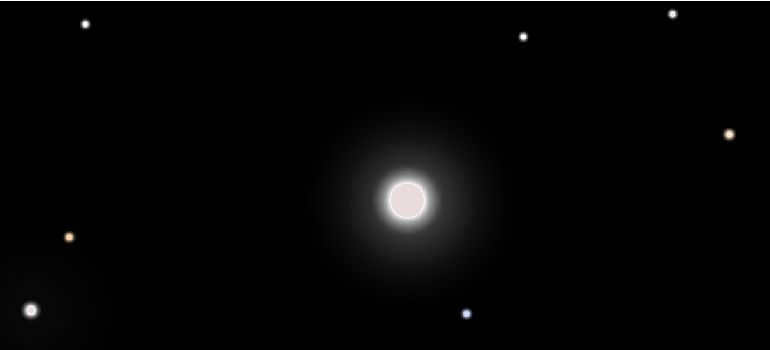
One of the most prominent celestial objects in the sky is Polaris. It is arguably the most renowned star in human history. Throughout ancient times, mariners and explorers have utilized this luminary to orient themselves to the cardinal directions. The star served as a guide to the north pole, aiding in the creation of maps and navigation routes. The history of its investigation is fascinating in its own right.
The pinnacle of fame and popularity for this celestial body occurred relatively recently. As researchers have discovered, the light emitted by the brightest star, Alpha Minor Bear, has gained such significance for humanity in recent times. However, it is not the brightest star overall.
Contrary to popular belief, Polaris is not visible from every location on Earth. So what is the underlying mystery behind the star’s popularity?
Polaris is situated in the constellation Ursa Minor. It possesses relatively straightforward characteristics, despite being a supergiant much older than the Sun. Its color can be described as yellowish, although it is often perceived as white. Polaris bears little resemblance to the Sun, with a surface temperature of 6000 K, which is similar to the heating of our own star. The diameter of this northern star is 23 times larger than that of the Sun. Its level of luminosity is 23 times brighter than the Sun, surpassing even the brilliant Sirius. However, the distance to Polaris remains incalculable to this day. Both its brightness and heating parameters can vary.
What is the scientific name for Polaris? It is known as Alpha Ursa Minoris, or UMi Aa.

What makes this star so well-known?
It gained its prominence in the night sky due to its close proximity to the hidden axis of the Earth and the North Pole. By visualizing a line connecting the Earth’s poles, extending northward, one can observe that this celestial object lies directly on that line. From any location in the Northern Hemisphere, the axis of rotation can be determined by observing the sky.
This information is not relevant for the Southern Hemisphere. You will never observe this celestial body there. This statement already contains an exaggeration regarding the importance of this star in navigating the seas. In reality, sailors primarily traveled on the oceans and seas of the northern hemisphere. Navigation was actively developed in that region. The exploration of the southern seas and oceans began during the era of the Great Geographical Discoveries. It was then that it was noticed that there was no permanent landmark in the southern part of the planet. However, it was sailors who popularized the use of this celestial body for navigation. It was the simplest option for determining the northern point and other directions during voyages, as there were no other reference points available.
Locating Polaris in the Night Sky
The primary celestial marker for finding Polaris, also known as the North Star, is the Big Dipper. The Big Dipper is a prominent asterism that can be seen in the northern hemisphere throughout the year. Its position in the sky varies depending on the season. During winter, it is closer to the horizon, while in spring it is more towards the east. In summer, it shifts towards the west. Another helpful reference point is the star Alpha of the Little Bear, which is a part of the smaller “bucket” of stars. Although not as easily visible, it can assist in locating Polaris. By mentally drawing a line from the two outermost stars of the Big Dipper and extending it upwards for five times their distance, you will arrive at Polaris. For a visual representation of this process, refer to the accompanying image. Once you follow these steps, you will be able to easily identify Polaris in the night sky.
Will Polaris always maintain its current position?
Due to the continuous movement of all celestial bodies, the Earth is constantly orbiting. This movement causes a shift of approximately 1.4 degrees every 100 years in the position of the Earth’s North Pole. Consequently, other stars have the potential to align with the world’s North Pole over time. Presently, the star closest to the North Pole is Polaris. However, this is only its temporary position, with a deviation of less than 1 degree. The minimum deviation occurred in 2012, and since then, Polaris has been gradually moving away from the Northern axis. In the future, another star will take over as the new Polaris.
The precise measurement of Earth’s distance
Discussions surrounding the exact distance to Earth are ongoing, and a definitive figure has yet to be determined. Currently, it is estimated to be approximately 133 parsecs (434 light years). However, there are alternative theories suggesting that the trajectory is actually 30% shorter, particularly in relation to the nearest Cepheid.
The composition of the Polaris star system
Within the constellation Ursa Minor, Polaris is accompanied by several satellites, which are designated as AA, AB, and B. Each satellite possesses unique characteristics and attributes. The presence of these satellites allows for the measurement of stellar object masses.
In fact, the main character surpasses the Sun in mass by 4.5 times. It is classified as an F7 supergiant. But where did the satellites originate from? Researchers speculate that Polaris and its neighboring stars are the outcome of a massive star cluster being dispersed. The distance separating them spans 100,000 light-years.
Polaris AB
This companion is categorized as an F6 spectrum with a mass of 1.26 solar masses. Its light remained undetected until 2006 when it was finally observed. Because of its close proximity to the primary star, its radiation was obscured by the primary star’s glare. It is located approximately 100 parsecs away from Earth. Similar to its neighboring stars, it has an estimated age of 80 million years. Polaris AB orbits a binary star system and has been accumulating nuclear fuel for millions of years. Considering that color is indicative of age, it can be presumed that the companion also formed approximately 80 million years ago.
Polaris B
Another smaller companion to the Sun is Polaris B, which has a mass 1.4 times that of the Sun. It falls under the F3 spectrum and can only be seen through a telescope. However, even the simplest telescope will suffice. This discovery was made by the astronomer Herschel in the 18th century when he constructed his own reflector.
Polaris also has two other small satellites, C and D, but they have little to do with the main star.
Physical characteristics and orbit
The physical characteristics and orbit of an object are its unique features and path in space.
The physical characteristics refer to the specific attributes and qualities that distinguish the object from others. These can include size, shape, composition, and surface features. For example, a planet may have a rocky surface, while a moon may have a smooth and icy surface.
The orbit of an object refers to its path or trajectory as it moves through space. This can be influenced by the gravitational forces of other objects in the solar system. For example, a planet may have a circular or elliptical orbit around the sun, while a moon may have an orbit around its parent planet.
Understanding the physical characteristics and orbit of an object is crucial for studying and exploring celestial bodies. It helps scientists determine the object’s origins, formation, and behavior in space. This information can also provide insights into the overall structure and dynamics of the solar system.
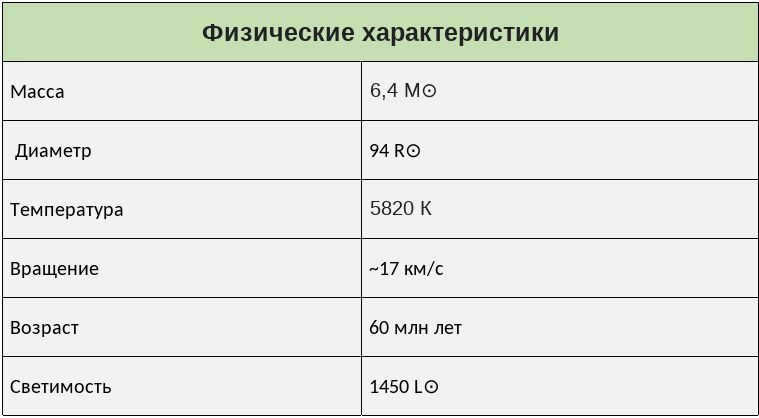
Now the Alpha star in the constellation Ursa Minor has a luminosity of 1.97, making it quite bright. It also has a very precise northward direction, with an accuracy of 1 degree. The surface temperature of the star is approximately 6,000 Kelvin.
The lifespan of a supergiant
When comparing Polaris to the Sun, it becomes evident that Polaris has a relatively short lifespan. Once it depletes its hydrogen fuel in the core, it will eventually burn out. Other older giants have already gone through this stage in their life cycle, which means that the Sun will continue to shine for a much longer period of time.
Long ago, according to theories, Polaris used to be a massive blue giant star located in the Milky Way galaxy. It fell under the B category in the spectrum, having a mass five times greater than that of the Sun and a radius 3.5 times larger. The temperature at the outer layer of this celestial body was measured at 18,000 Kelvin, which is three times higher than the temperature of our Sun. Nevertheless, these pieces of information are from a distant era, belonging to history, and at present, this entity has transformed into something considerably “humbler”.
Fascinating Trivia
Across various cultures around the world, the polar star is known by different names. Due to its significance in cartography and navigation, it has been referred to as the Divine Eye and the Canine Appendage (as it is situated at the end of the “container”).
Within Arab culture, Polaris was seen as a celestial pit. Moreover, it was considered to be “sinister” (Al-Kiblah) because it vanquished a heavenly warrior. He is interred in a mausoleum akin to the prominent constellations Ursa Major and Ursa Minor.
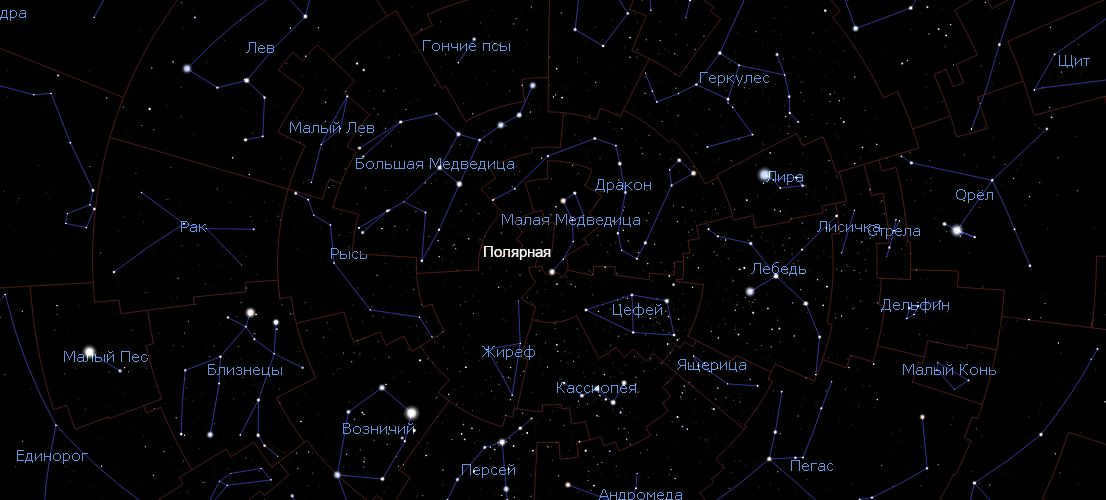
The Cepheid Stars
There exist numerous counterparts to this celestial body, with a multitude of similar entities in the vastness of space possessing near-identical characteristics. The level of distinctiveness of Alpha can be considered rather low. In order to classify these stars, astronomers have grouped them together into a single category known as Cepheids, named after one of the stars found within the Cepheus system. While their pulsations bear a striking resemblance, the objects themselves differ in terms of mass, temperature, amplitude, and various other parameters, as only neutron stars can be truly identical. The common factor among them lies in their pulsation periodicity: the longer the duration of the pulsation period, the more brilliant the streams of light emitted.
The Utilization of Cepheids in Astronomy
By comprehending the correlation between pulsations and time intervals, scientists have been able to compute the cosmic distance to any nearby galaxy containing Cepheids. In general, astronomers primarily engage in theoretical calculations based on astronomical data. Presently, 40 luminaries from this classification are observed in the night sky. These stars are known as “classical” Cepheids as they are visible without the need for specialized equipment. So, what makes Polaris distinctive in this group? Firstly, it serves as a reliable marker for the north and is also the closest and brightest star. Furthermore, the variability of such stars is crucial for astronomers as it provides a convenient celestial “ruler” and serves as an intriguing subject for further research.
Polaris, also known as the North Star, is a celestial object located in the constellation of Ursa Minor. It is classified as a supergiant based on its spectral characteristics. Currently, Polaris maintains a fixed position in the sky, taking into account the Earth’s daily rotation. This makes it an incredibly useful tool for navigation, as the direction to the North coincides with the direction to Polaris. Furthermore, Polaris is a bright and relatively close pulsating variable star. What makes it even more intriguing is that its pulsations can change over certain time intervals.
Report #2
Polaris, also known as the Guiding Star, has been a source of fascination for scientists across a range of disciplines for centuries.
This particular star, located in the northern hemisphere, falls into the category of supergiants, indicating its advanced age of 80 million years and the significant changes it has undergone. By studying the light emitted by Polaris, scientists have determined that its lifespan is nearing its end, as the star will cease to exist once hydrogen is no longer present in its core.
Similar to all stars, Polaris has its own unique trajectory of movement.
The measurements of Polaris surpass those of the Sun in every aspect: it is 6.4 – 6.7 times more massive, has a diameter 25 times larger, and is hotter with a surface temperature of 6000 K. Additionally, Polaris shines with a brightness 2000 times greater than the Sun. However, despite these impressive characteristics, Polaris is not the brightest star in the sky. In the Super Galaxy, it ranks 46th among the brightest stars.
Another interesting fact is that Polaris is located directly above the North Pole, making it visible in the zenith. In the southern hemisphere, it cannot be seen, and can only be observed at the equator due to atmospheric refraction of light.
The enigmatic and radiant North Star has been a source of intrigue for scientists for many centuries. Even in modern times, astronomers are still working tirelessly to uncover the secrets of this celestial body. While it serves as a guiding light for lost travelers, providing them with a sense of direction towards the north, it remains an elusive and enigmatic entity for scientists.
Unraveling the Mystery of the North Star
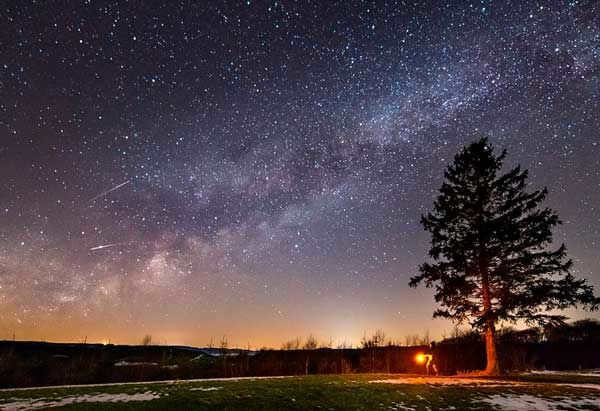
In 1612, it appeared that the Russian state’s existence was in jeopardy. The Poles had complete control over Moscow and attempted to govern all of Russia through their puppets. The Swedes ruled without opposition in the northern regions of Russia, while the south was devastated by hordes of Crimean Tatars.
Our nation possesses an immense variety of plants, some of which possess medicinal properties. However, there are also hazardous plants, mishandling of which can lead to calamity.
The primary abode for feudal lords in Europe was the castle, a sturdy stone structure. The construction of such fortifications began in the 10th century and took a considerable amount of time to complete.
Polaris can be found in the handle of the Little Dipper asterism in the Ursa Minor constellation and is approximately 447 light years away from Earth. In ancient Greece, it was referred to as the dog’s tail. The diagram below illustrates the precise location and method of locating Polaris in the night sky. Utilize our star map to facilitate your search when using a telescope.
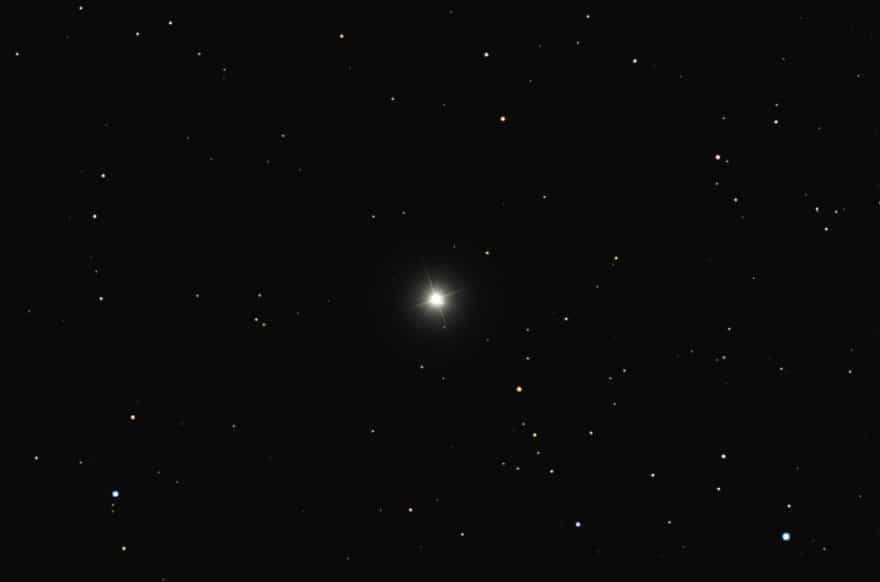
Enhanced perspective of the Polaris constellation
Polaris is currently positioned 1.5 degrees apart from the Earth’s celestial pole. Due to the ongoing precession of the Earth’s axis, this celestial pole is gradually shifting towards the Polaris star. By the year 2105, it is projected to approach within a distance of 14 angular minutes from Polaris before starting to diverge. Ultimately, another celestial luminary will assume the role of guiding star.
Discovering the North Star: A Guide
The Small Bucket asterism may not possess extraordinary luminosity, making it challenging to locate in the celestial sphere. However, you can utilize the stars of the Big Bucket asterism within the Big Dipper constellation as a helpful guide.
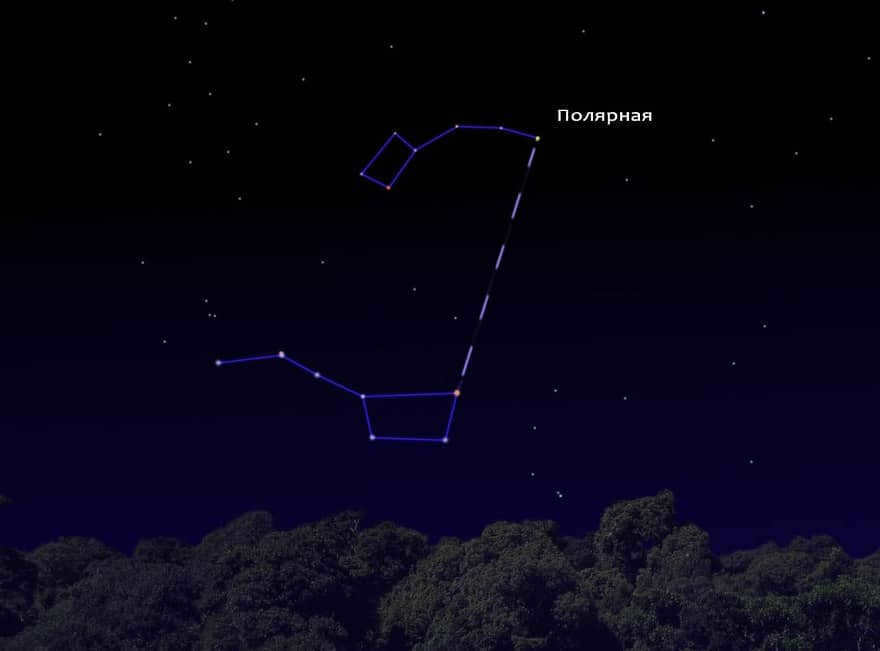

If you want to find Polaris, you can draw a line from Merak to Dubhe and divide it into 5 equal sections. In the image, Dubhe, Merak, Fedha, Megrez, Aliot, Mitzar, Alkaid, and Polaris are all visible.
To locate Polaris in the night sky, you can use the stars Dubhe and Merak in the constellation known as the Big Dipper. These stars are located on the outer edge of the Big Dipper. By drawing an imaginary line and measuring 5 equal segments, you will be able to find the North Star, which is Polaris. The Big Dipper revolves around Polaris, completing one revolution in 23 hours and 56 minutes.
Polaris can be easily located due to its alignment with the Earth’s axis of rotation, making it appear to be directly above the North Pole. It remains nearly stationary, giving the illusion that all other stars are orbiting around it. This star maintains its position throughout the year. The method of observation varies based on your geographical location. In New York City, for example, you can spot Polaris approximately 41 degrees above the northern horizon, corresponding to the city’s latitude. In equatorial regions, Polaris will be visible right at the horizon. As you move further north, the star will appear lower below the horizon line.
Polaris, located in the constellation Ursa Minor, has served as a valuable tool for navigation since ancient times. Currently, it is positioned 0.7 degrees away from the North Pole. However, this star did not always hold the title of North Star. In 2500 B.C., the celestial pole resided within the constellation Draco. Then, in 400 B.C., the navigational star of choice was Beta Ursae Minoris. Looking ahead to the year 14000, the star Vega in the constellation Lyra will take over as the designated North Star.
A significant event is projected to occur on March 24, 2100, when Polaris will make its closest approach to the North Pole, resulting in a distance of 27.15 angular minutes between the two. Interestingly, there are no bright stars in the southern hemisphere that can serve as celestial navigators during this approach. Furthermore, no such stars will emerge within the next 2000 years.
The Polaris system
It is important to remember that in front of us lies an entire star system, possessing unique features and classification. The primary star within this system is a yellow supergiant, known as Alpha of the Little Bear Aa, with a spectral type of F7. This star shines with a brightness 2500 times greater than the Sun, and possesses a mass 4.5 times larger, as well as a radius 46 times larger, than our own Sun. Additionally, it belongs to the variable cepheid class, demonstrating pulsations over a period of four days.
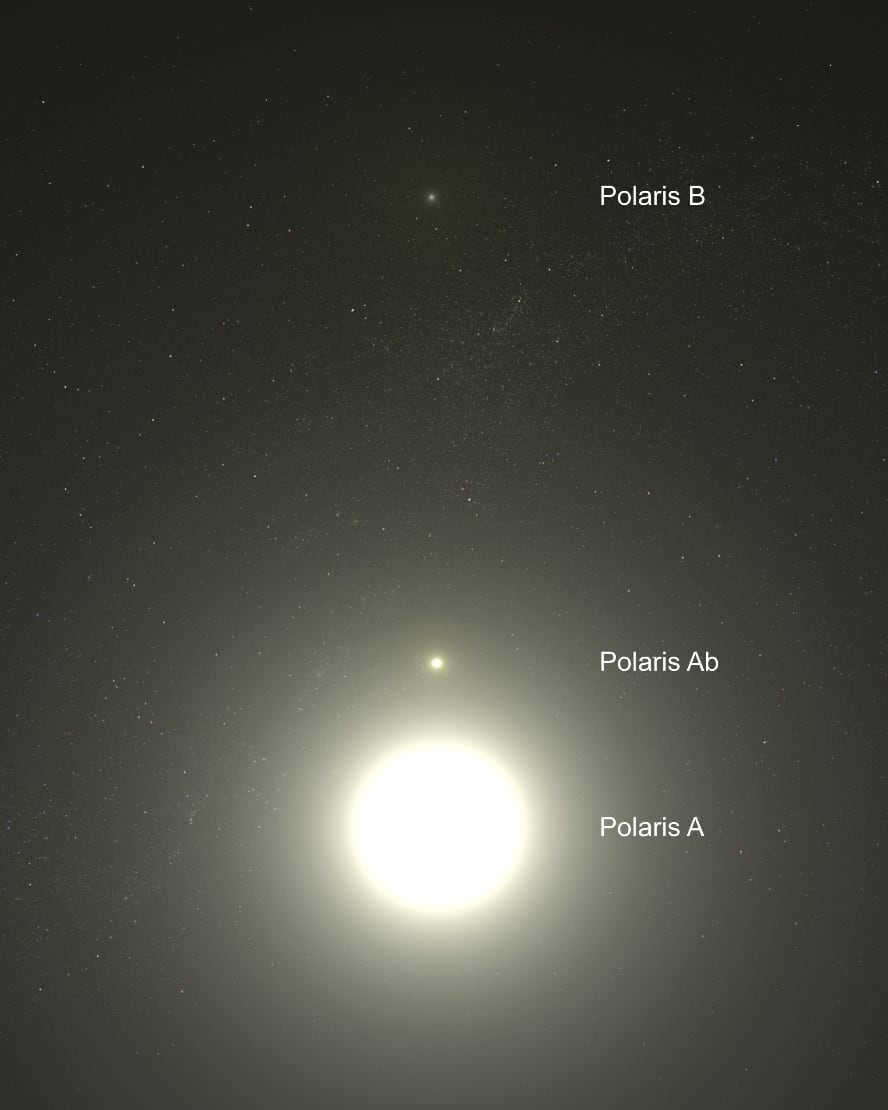
Polaris A is a type of variable star known as a classical Cepheid, and it holds the distinction of being the brightest star of its kind in the night sky. Scientists rely on these stars to measure distances between galaxies and star clusters. Polaris A experiences fluctuations in its brightness, with a variation of 0.03 magnitudes occurring over a period of 3.97 days. The concept of variable star brightness was first proposed in 1852, but it wasn’t until 1911 that this phenomenon was confirmed.
From its discovery until 1963, Polaris A exhibited an amplitude of 0.1 magnitude, which gradually decreased. However, after 1966, the magnitude began to approach 0.05. Currently, scientists have observed a consistent increase of 3.2 seconds per year in the period of Polaris A’s brightness variability.
The star Alpha Minor Aa has two companions. One of them is Ab, which is a dwarf star (F7) located 17 astronomical units away, and it takes 29.6 years for Ab to complete one orbit around Alpha Minor Aa. Another companion, Alpha Minor B, is a dwarf star (F3) located 18 arc seconds away from Alpha Minor Aa, and it has an orbital period of 42,000 years. Astronomer William Herschel first discovered Alpha Minor B in 1780.
In addition to these two companions, Alpha Minor Aa has two more satellites, C and D. The north celestial pole is situated between Polaris and Lambda, which is a star in the Little Bear constellation.
In 1929, the binarity of Polaris A was confirmed. The Hubble Space Telescope discovered all three stellar components in 2006. Since the time when Greek astronomers made their observations, the brightness of the star has increased by a factor of 2.5.
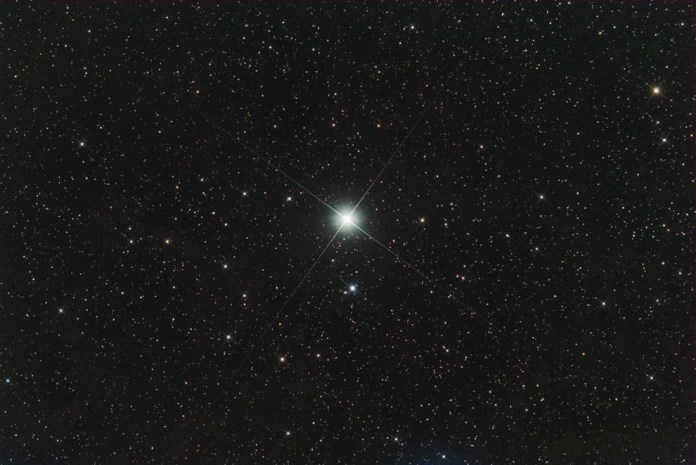
Polaris, also known as Alpha Minor Bear (α UMi), is the closest relatively bright star in the northern hemisphere. It is located at a distance of 323 to 433 light-years (99 to 133 parsecs) from Earth. Polaris has a visible brightness that varies between 1.86 and 2.13 magnitudes. It is categorized as a Classical Population I (metal-rich) Cepheid variable and holds the distinction of being the nearest star of its kind to our planet.
Analysis of Polaris
Although Polaris does not precisely indicate the precise position of the north pole, it is in close proximity to it. It aligns with the Earth’s northern axis of rotation, which is nearly directly above the north pole. Due to this alignment, Polaris does not appear to rise or set for individuals located in northern latitudes. Its proximity to the north celestial pole gives it the appearance of being stationary in the sky. This characteristic makes Polaris highly valuable for navigation and astrometry purposes.
Polaris became the North Star after Cohab (the Beta star of the Little Bear) around 500 AD. Cohab, the second brightest star in the Little Bear, held this position from 1500 BC to 100 AD. Presently, Cohab and Ferkad (the Gamma star of the Little Bear) are recognized as the “guardians of the Pole”.
Out of all the stars in the north, Polaris is the second nearest to the pole. The only star that accurately indicates true north better than Polaris is Thuban, which belongs to the Dragon constellation. Thuban is approximately 0.2° away from the pole, while Polaris is within 0.5°. Thuban is significantly dimmer, making it slightly less useful as a reference point when it was Polaris between 4,000 and 2,000 BC. The brightest star among the northern stars, Vega, has an apparent magnitude of 0.026, but it is only within 5° of the pole.
Polaris is expected to return to its position as the North Star around 27,800, although it will not be as closely aligned with the pole as it is currently or as it was around 23,600 B.C., when it was even closer to the pole than it is now.
Without a doubt, Polaris is one of the most renowned and beloved celestial objects. It is highly likely that every individual has some knowledge of it.
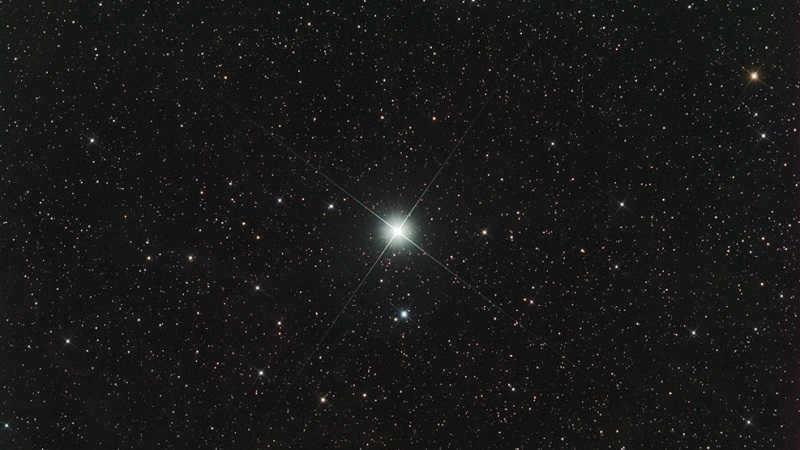
Nowadays, the position of Polaris has been replaced by the celestial object known as Alpha in the constellation of Ursa Minor.
As per scientific research, Polaris is classified as a delta Cepheid variable star, commonly referred to as a Cepheid.
Interestingly, Polaris is known for its pulsations, which have been gradually decreasing over the course of several decades. To put it into perspective, its brightness fluctuated from 8% to 2% between 1900 and 2005. However, overall, Polaris has become significantly brighter during this time period.
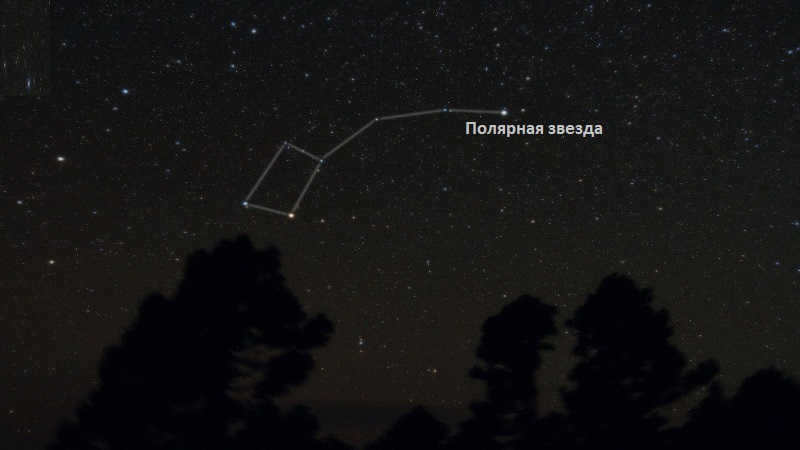
The constellation known as the Little Bear is quite fascinating. It stands out as the most luminous and nearest among its kind to our planet. Its magnitude is +2.0m, making it easily visible. Currently, it is located at a distance of about 447 light years or 137 parsecs away from Earth.
What makes Alpha Minor particularly interesting is its proximity as a Cepheid, a type of pulsating variable luminary. This is significant when it comes to measuring astronomical distances.
Cepheids are a specific class of pulsating variable luminaries that follow a period-luminosity relationship.
What is the name of the North Star?
The name of the North Star, Polaris, is derived from its position in the night sky.
Throughout history, this famous celestial object has been known by various names.
In ancient Greece, it was called Kinosura, which translates to “the tail of a dog.” In England, it is referred to as the pole luminary, a celestial body that commands attention and admiration.
Another common name for Polaris is the Guiding Star or the North Star, reflecting its location and navigational significance.
Polaris serves as a guiding beacon in our sky.

Overview of Polaris
To begin with, Polaris, also known as Alpha of the Little Bear, is not just an ordinary star, but a complex stellar system consisting of three distinct components.
At the core of this system lies a supergiant star called Polaris A (α UMi A), which has recently been discovered to have a companion star known as Polaris P (α UMi P). Interestingly, Polaris A and Polaris P form a close binary star system. It is worth mentioning that Polaris A, being a supergiant, is one of the most luminous stars in the sky.
Lastly, there is a third component known as Polaris B, which is located at a significant distance from the central object.
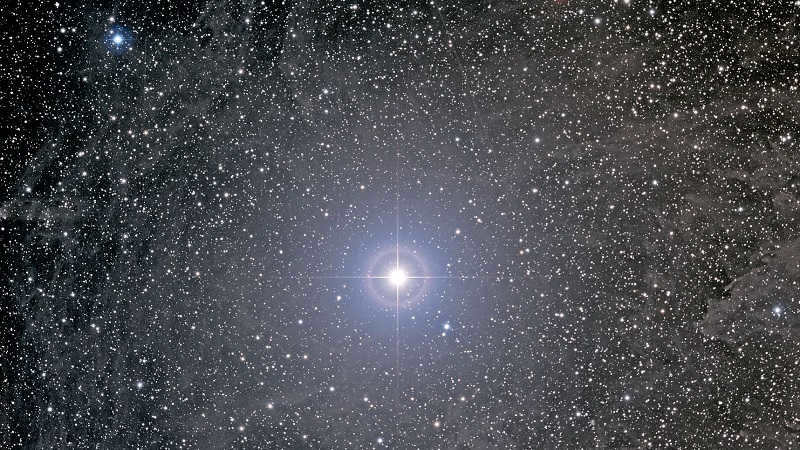
When discussing the attributes of Polaris, it is crucial to grasp its physical traits. Remarkably, it shines more brightly than our Sun and also possesses a bigger magnitude (Polaris from Hubble).
Other characteristics of Polaris
Due to luni-solar precession, the Earth’s axis undergoes a circular movement, causing different celestial bodies to come closest to the North Pole over time. Since Polaris is a specific name, it can be replaced by various objects at different periods.
For instance, at one point in time, the following were positioned above the northern point of the horizon: Vega – α Lyra; π, η, and τ of Hercules; ι, and α Dragon; β of the Little Bear.
By the way, this is the famous circle of precession, where the position of the stars in relation to the celestial equator changes.
What do you think is the altitude of Polaris? Its altitude above the horizon corresponds to the latitude of the location where the observation is made. Actually, it points almost directly north.
It is situated above the northern point of the horizon in the Northern Hemisphere. That’s why it is used in navigation and determining latitude.
Many people are curious about what is brighter than Sirius or Polaris. To be clear, Sirius is the brightest star in the sky, while Polaris is the brightest among the stars in the Northern Hemisphere.
So, here’s the question that comes up: how much brighter is Sirius than Polaris? Well, it turns out that Sirius is 27 times brighter! However, it’s important to note that Polaris is 53 times farther away. This means that Polaris actually has a luminosity level that is 300 times greater than Sirius.
Where can you find Polaris in the night sky?
Polaris is actually located near the North Pole of the Earth. Specifically, it can be found in the constellation of Ursa Minor, also known as the Little Bear.
Scientists say that Polaris is currently less than 1° away from the North Pole. This means that it appears almost stationary in the daily rotation of the celestial sphere. So, if you’re at the North Pole, you’ll see Polaris right above you at the zenith.
To locate the North Star, one must first locate the Big Bucket asterism within the Big Dipper constellation. This asterism is formed by seven bright stars that resemble a pot with a handle. Two of these stars, Dubhe and Merak, form the walls of the ladle. Drawing an imaginary line through these walls towards the handle, one must then measure a distance equal to five times the segment between the walls. At the end of this line lies the Alpha star of the Little Bear.
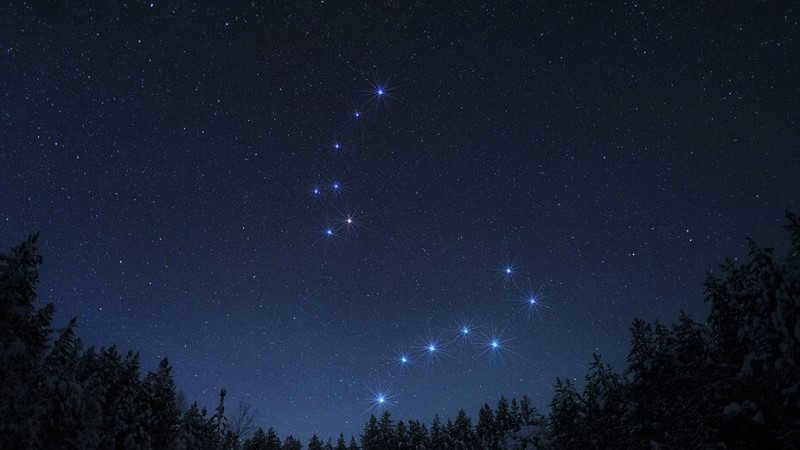
The constellations of the Big and Little Medeveditsa.
What is the Southern Polaris
In the southern hemisphere, it is impossible to observe the Northern luminary. Consequently, it is simply impossible to orient oneself by it. There is not even a hint of a shadow from Polaris.
Essentially, the Southern Polaris is a celestial body that is situated at the South Pole, specifically on its axis. However, there is currently no such star. The closest one is Sigma Octanta. Nevertheless, it cannot be utilized as a navigational aid. In such instances, people sometimes refer to the Southern Cross constellation because it at least points in the direction of the South Pole. One could say that it serves as a sort of point of reference.
Polaris (), also known as α Ursae Minoris (Alpha Minor of the Little Bear), abbreviated as Alpha UMi or α UMi, is the most brilliant star in the constellation of the Little Bear. It is in close proximity to the Earth’s north pole, which makes it the current north polar star. With the updated Hipparcos parallax, the distance to Polaris is estimated to be approximately 433 light-years (133 parsecs), while calculations using alternative methods indicate distances that are about 30% closer.
Polaris is a triple star system that consists of a primary star, Polaris Aa (a yellow supergiant), in orbit with a smaller companion (Polaris Ab); and another pair in orbit with Polaris B (which was discovered by William Herschel in August 1779).
- 1 Star system
- 2 Observation
- 2.1 Variability
- 2.2 Role of Polaris
Stellar System
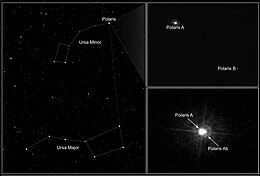
Elements of Polaris observable through the Hubble Space Telescope
Polaris Aa, a yellow supergiant of spectral class Ib with a mass of 5.4 ( M ☉ ), is comparable to the Sun. It is the first classical Cepheid whose mass has been determined based on its orbit. Polaris B, a main-sequence star of spectral class F3 with a mass of 1.39 M ☉, is one of the smaller companions and orbits at a distance of 2400 astronomical units (AU). Polaris Ab (or P), a very close main-sequence star of spectral class F6 with a mass of 1.26 M ☉, is also present.
Polaris B is visible in a modest telescope. The star was discovered by William Herschel in August 1779 using his own reflector telescope, which was considered one of the top telescopes of that era. Upon studying the spectrum of Polaris A, it was also determined in 1929 that it is a very close binary system with a secondary dwarf (also known as α UMi P, α UMi an, or α UMi Ab), which had been hypothesized in previous observations (Moore, J. H. and Cholodowski, E. A.). In January 2006, NASA released images from the Hubble Telescope that showcased the three members of the Polaris triple system.
There were originally believed to be two additional distant components – Polaris C and Polaris D – but it has since been proven that they are not physically connected to the Polaris system.
Observation
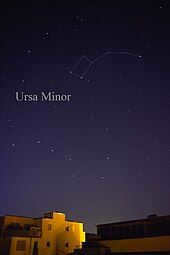 Polaris, situated at the top right of the constellation of the Little Bear, stands out as the most luminous star.
Polaris, situated at the top right of the constellation of the Little Bear, stands out as the most luminous star. 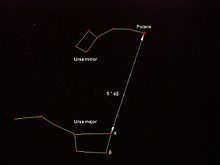 When looking at the Big Dipper and Little Dipper in relation to Polaris, one can clearly see their positions.
When looking at the Big Dipper and Little Dipper in relation to Polaris, one can clearly see their positions. 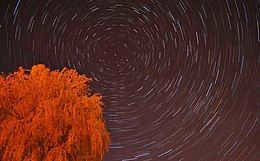 In a typical Northern Hemisphere star trail, Polaris takes the center stage, guiding the other stars. When observed through a small telescope, Polaris can be seen with Polaris B, which is located 18 angular seconds away from it.
In a typical Northern Hemisphere star trail, Polaris takes the center stage, guiding the other stars. When observed through a small telescope, Polaris can be seen with Polaris B, which is located 18 angular seconds away from it.
Variability
Polaris Aa, the primary constituent of the supergiant, is a classical variable Cepheid of population I with a small amplitude, even though it was previously categorized as a Type II Cepheid due to its high galactic latitude. Cepheids play a crucial role as a standard candle in measuring distances, and therefore, Polaris, being the nearest star of its kind, has been extensively researched. The variability of Polaris was first suspected in 1852, and this fluctuation was later confirmed by Einar Hertzsprung in 1911.
The range of Polaris’ brightness during its pulsations is 1.86-2.13, however, the amplitude has undergone changes since it was first discovered. Prior to 1963, the amplitude was greater than 0.1 stellar magnitude and gradually decreased. From 1966 onwards, it rapidly decreased to less than 0.05 stellar magnitude. Since then, it has been fluctuating unpredictably within this range. Recent reports suggest that the amplitude is now increasing once again. No reversals have been observed in any other Cepheid.
The duration of approximately 4 days has undergone changes over time. It has consistently increased by about 4.5 seconds per year, with the exception of a break in 1963-1965. Initially, it was believed that this was due to the gradual shift towards a red hue along the cepheid instability band. However, it is now suggested that it could be a result of interference between the primary and first overtone pulsation modes. There is disagreement among the authors regarding whether Polaris is a primary or first overtone pulsator, as well as whether it crosses the instability band for the first time or not.
The temperature of Polaris experiences only a slight change during its pulsations, but the extent of this change is inconsistent and unpredictable. The irregular temperature fluctuations and the range of temperature changes during each cycle, ranging from less than 50 K to at least 170 K, may be linked to the orbit with Polaris Ab.
According to a study published in Science, recent research indicates that Polaris is currently 2.5 times more luminous than it was during Ptolemy’s observations. This means that it has transitioned from being a star of third magnitude to second magnitude. Astronomer Edward Guinan finds this transformation to be quite extraordinary and has stated that if these observations are accurate, they represent a discrepancy that is 100 times larger than what current theories of stellar evolution predict.
Polaris is referenced in Nathaniel Bowditch’s book, American Practical Navigator, published in 1802, where it is included as one of the navigational stars. Polaris’s azimuth is pointed towards true north twice in each sidereal day; during other times, it shifts either east or west, and the azimuth has to be adjusted using tables or a rule of thumb. The most accurate approximation was achieved by using the front part of the Big Dipper constellation, known as the Big Dipper asterism. The front part, marked by the stars Dubhe and Merak, was aligned with a dial, allowing for the calculation of Polaris’s true azimuth for different latitudes.
Names
Monikers
Labels
Designations
Appellations
Titles
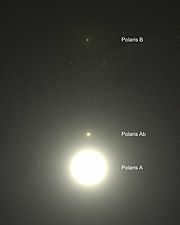
This illustration shows the massive star Polaris Aa, the small star Polaris Ab, and the distant small companion Polaris B.
The current name Polaris comes from the Latin word “stella polaris” which means “polar star”. This name was given during the Renaissance when the star came close to the pole of the sky. In 1547, Gemma Frisius named it “stella illa quae polaris dicitur” which translates to “that star which is called” polar. It was located 3° 8′ from the pole of the world.
In 2016, the International Astronomical Union established the Working Group on Star Names (WGSN) to record and standardize proper names for stars. The first bulletin of the WGSN in July 2016 included a list of the first two groups of approved names, which included Polaris α of the Little Bear Aa.
Back in ancient times, Polaris didn’t hold the title of being the closest star visible to the naked eye at the celestial pole. Instead, the entire constellation of the Little Bear was used for navigation, without any specific star being singled out. As time went on, Polaris gradually moved closer to the pole, eventually becoming the closest star visible to the naked eye. However, even during the early Middle Ages, it was still a few degrees away. Since that time, many names referencing this characteristic, such as polaris, have been used. In Old English, it was referred to as “scip-steorra” or “star-ship.” Old English runic poetry connects the T-rune with the “circumpolar constellation,” associating it with qualities like fortitude and honor.
In Hindu mythology, the concept of the guiding star, known as Dhruva (“still, immovable”), was personified. In the later medieval period, it became linked to the title of Mary of Stella Maris, also known as the “Star of the Sea” (as mentioned in Bartholomeus Anglicanus, ca. 1270s). The older English term, lodestar, meaning “guiding star,” has been documented since the 14th century and is related to the Old Norse leiðarstjarna and Middle High German leitsterne.
The constellation of the Little Bear, known by its ancient name Kinosura (derived from the Greek word κυνόσουρα meaning “dog’s tail”), became closely associated with the polar star, especially during the Early Modern period. The explicit connection between Mary and the polar star, also known as Stella Polaris, can be seen in the title Cynosura seu Mariana Stella Polaris (meaning “Cynosure, or Mariana Polaris”), a collection of poems dedicated to Mary published by Nicolaus Lucensis (Niccolo Barsotti de Lucca) in 1655.
In traditional pre-Islamic Arabic astronomy, the constellation was called Al-Judeyy الجدي, and this name continued to be used in medieval Islamic astronomy. At that time, it was not yet as close to the north pole as it is today and was observed to rotate around the pole.
In poetry, the north star has been historically used as a symbol of steadfastness. For example, in Spenser’s poem, it is referred to as the “unwavering star.” Shakespeare’s Sonnet 116 also explores this symbolism, describing love as a guiding star for lost ships, emphasizing its unknown worth and undeniable significance. In Julius Caesar, the character Caesar uses the north star to explain his unwavering nature, comparing himself to the star’s fixed and constant qualities. He highlights that while the heavens are filled with countless shining sparks, only one star takes its rightful place. However, it is important to note that Polaris, the current north star, will eventually change due to precession, although this change will only be noticeable after centuries.
Distance
Stellar parallax serves as the foundation for the measurement of a parsec, which represents the distance between the Sun and an astronomical object that exhibits a parallax angle of one arc second. (Please note that the scale of 1 a.u. and 1 pc is not accurate, as 1 pc is approximately equal to 206,265 a.u.)
Several recent scientific papers have conducted calculations to determine the distance to Polaris, resulting in an estimate of about 433 light years (equivalent to 133 parsecs). These calculations align with the parallax measurements obtained from the Hipparcos astrometric satellite. Previous estimations of the distance were slightly smaller, but recent studies employing high-resolution spectral analysis propose a potential adjustment of 110 light-years closer (equivalent to 323 svL / 99 pc). Given its proximity to Earth, Polaris holds significant importance in establishing the overall astronomical distance scale. Furthermore, it stands as the lone celestial body with a dynamically measurable mass.
| A | 330 light-years (101 parsecs). | Turner |
| A | 433 light-years (133 parsecs) | Hipparcos |
| B | 359 light-years (110 parsecs) | Usenko and Klochkova |
| B | 323 light-years (99 parsecs) | Turner et al. |
| A | ≥ 385 light-years (≥ 118 parsecs) | Neilson |
| B | 521 light-years (160 parsecs). | Bond et al. |
| B | 445.3 light-years (136.6 parsecs) | Gaia DR2 |
| A new set of observations was conducted between 1989 and 1993, and it was first published in 1997. |
| The statistical distance was calculated using the preliminary faint distance. |
The Hipparcos spacecraft utilized stellar parallax to conduct measurements from 1989 to 1993, achieving an accuracy of 0.97 milliseconds (970 microseconds). It successfully obtained accurate measurements for stellar distances up to 1000 pc. The Hipparcos data has undergone re-examination using more advanced error correction and statistical methods. While Hipparcos astrometry has its advantages, uncertainties in its Polaris data have been identified. Some researchers have raised questions regarding the accuracy of Hipparcos in measuring double cepheids like Polaris. The Hipparcos reduction specifically for Polaris has been revised and confirmed, but a consensus on the distance has yet to be reached.
The next significant advancement in high-precision parallax measurements is the Gaia mission. Launched in 2013, this space-based astrometric mission aims to accurately measure the parallax of stars to an impressive accuracy of 25 microseconds (μas). Originally, Gaia was intended to observe stars with a magnitude fainter than 5.7. However, tests conducted during the commissioning phase revealed that Gaia has the capability to autonomously detect stars with brightness up to 3. As of July 2014, Gaia has been configured to routinely process stars within the 3-20 star magnitude range. For stars brighter than 3rd magnitude, special procedures are employed to download raw scan data for the remaining 230 stars. Development of methods to reduce and analyze this data is currently underway. It is expected that these efforts will result in “full sky coverage at the bright end” with standard errors of “a few tens of μsecs”. Unfortunately, Gaia Data Release 2 does not provide a parallax measurement for Polaris. However, the estimated distance from Polaris is 136.6 ± 0.5 pc (445.5 sv years) for Polaris B, which is slightly farther away than previous estimates and significantly more accurate.
Polaris has always been significant in the realm of cosmic distance measurement due to its exclusive possession of direct distance data among Cepheids, which has had a profound impact on distance calculations utilizing this celestial “ruler”.
Historical Observations
| Ptolemy (around 169) | Yes |
| Al-Sufi (964) | Yes |
| Al-Biruni (around 1030) | Yes |
| Khayyam (around 1100) | Yes |
| Nasir al-Din al-Tusi (1272) | No |
| Ulugbek (1437) | Yes |
| Copernicus (1543) | Yes |
| Schoener (1551) | Yes |
| Brahe (1598) | Yes |
| Brahe (1602) | Yes |
| Bayer (1603) | Yes |
| De Houtman (1603) | No |
| Kepler (1627) | Yes |
| Schiller (1627) | Yes |
| Holly (1679) | No |
| Hevelius (1690) | Yes |
| Flamsteed (1725) | Yes |
| Flamsteed (1729) | Yes |
| Baude (1801a) | Yes |
| Bode (1801b) | Yes |





